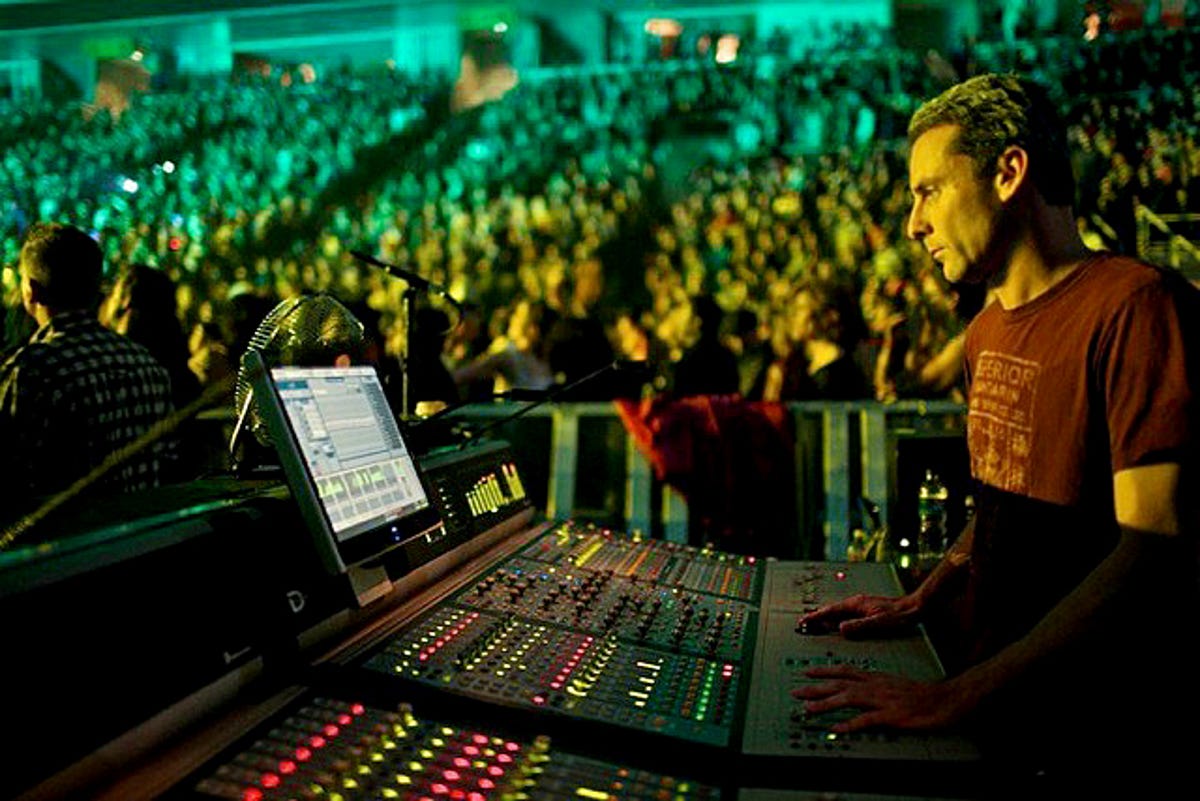
David Moncrieff II
David Haines is a front-of-house mix engineer for the Black Eyed Peas. Regular concertgoers are quick to spot the engineers in the barricaded “island” working the mixing board. Back there Haines is in a direct feedback loop between the band and the audience. It’s the mixer’s job to make sure the show’s emotional peaks are connecting with the fans. If he messes up, the band will lose the crowd, so the pressure might get to some people. Not Haines — he’s been with the ‘Peas for going on 19 years!
Haines describes his work as a collision of art and science. He knows the sound balance he wants, but getting there is never a straight line — it’s all about judgment calls. Haines is freer and less controlling than most of the sound engineers and techies I’ve met over the years. He never talked in engineering jargon; he’s much more interested in the “dance” between artists and the audience. Even when the ‘Peas have returned to the same venue after a few years, there’s always lots of changes in the sound systems, so Haines doesn’t even bother trying to recreate the mix that worked the last time they played there.
Watching U2’s “Unforgettable Fire” documentary as a kid, Haines knew he wanted to be an engineer. He comes from a musical family: his parents and grandparents played instruments and sang; Haines plays guitar, bass, clarinet and piano, and he grew up playing in bands. He hooked up with the Black Eyed Peas when he was still in college and recorded their first demos. He’s also worked with John Legend, Rihanna and Natasha Bedingfield.
The “back end” of a concert sound system — the amplifiers and massive PA speakers — is where the technology meets the real world, and the sound either moves the crowd or it doesn’t. Haines said, “Over the years you learn new techniques to make better sound. And you listen differently, so that’s what makes every concert fun, fascinating, and scary all at the same time.” It’s scary because it doesn’t matter how good the band is — if the sound isn’t great, the audience won’t connect with the music.
For US shows, the Black Eyed Peas bring their own sound system or they work with gear they requested. But if they’re playing, say, Dubai, the band might just bring their instruments and Haines will travel with a basic show file template to load into the console, which he hopes will work with his programs. If not, he’ll do his best with what’s at hand. Sometimes it can be pretty rough, and after the system is up and running, he might play some test tones and music to calibrate the system and dial things in. Haines knows from experience that you can go only so far with the mix during a sound check, but empty venues rarely sound good. The mix can only come together when the band is playing to a live audience.
Haines uses dynamic range compression to get the perfect balance for the Black Eyed Peas’ four vocalists, and looks for just the right “pocket” for the vocals in the mix with the band. He’s also trying to cover the band’s mistakes. If a guitar is slightly out of tune, he’s going to cut it back in the mix, and distract the audience with something else, maybe a keyboard. That’s part of the craft of live mixing.
When the Black Eyed Peas appear on big TV shows like Letterman, the Super Bowl or the Grammys, Haines won’t be in the same room with the band. He’s down in the basement working with the show’s broadcast mix crew. TV mixers usually want to overemphasize vocals, which upsets the vocals-to-instruments ratio and the music often suffers for it. TV is always a risky proposition for live music.
It’s interesting — Haines told me a lot of studio engineers are wary of crossing over to live sound mixing. He put it this way: “Some engineers need the illusion of control, and some want more chaos in their life, and I’m in the second category.” When the band is playing for 50,000 people, anything can happen.
Haines is also a surfer. “The challenge there is finding your feet and keeping your balance, channeling the power as you ride the wave.” He said, “Surfing taught me as much about live sound as any school. You’re getting pounded by waves, and at a show, you’re feeling the music move you. That’s the main objective.”




